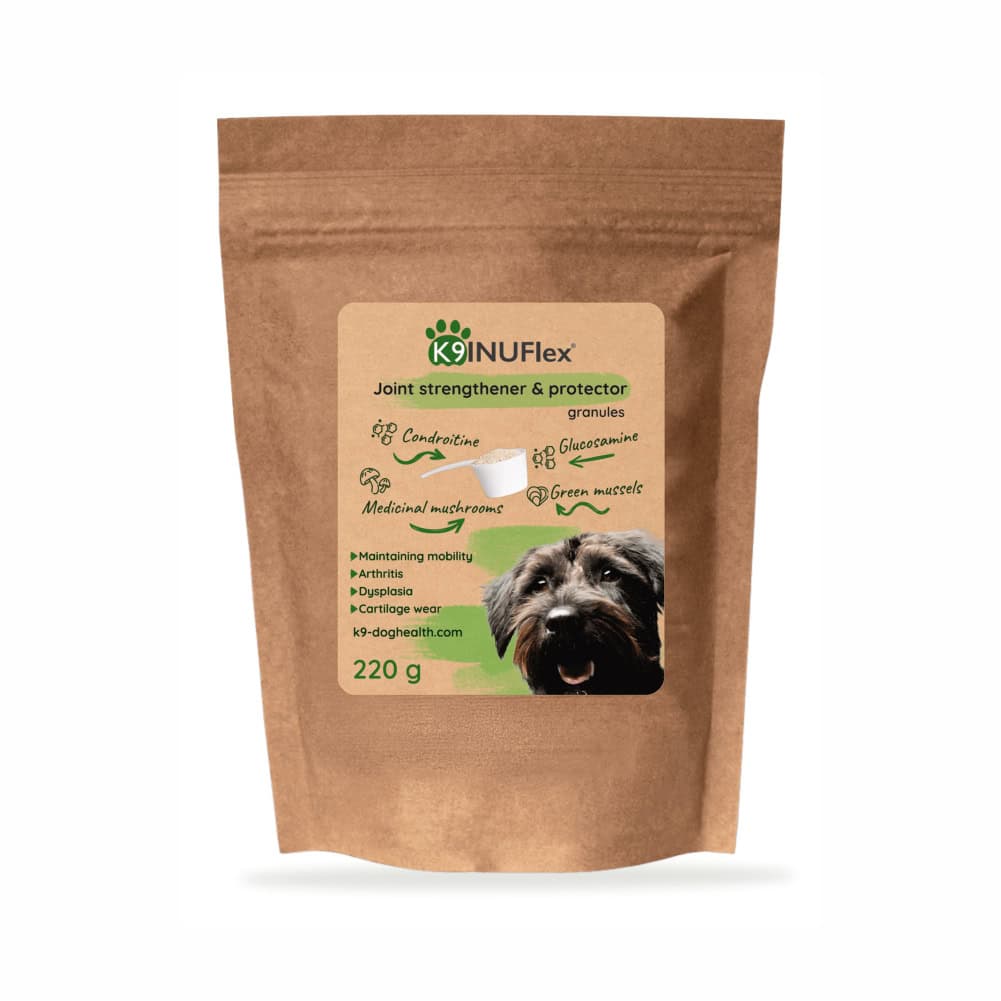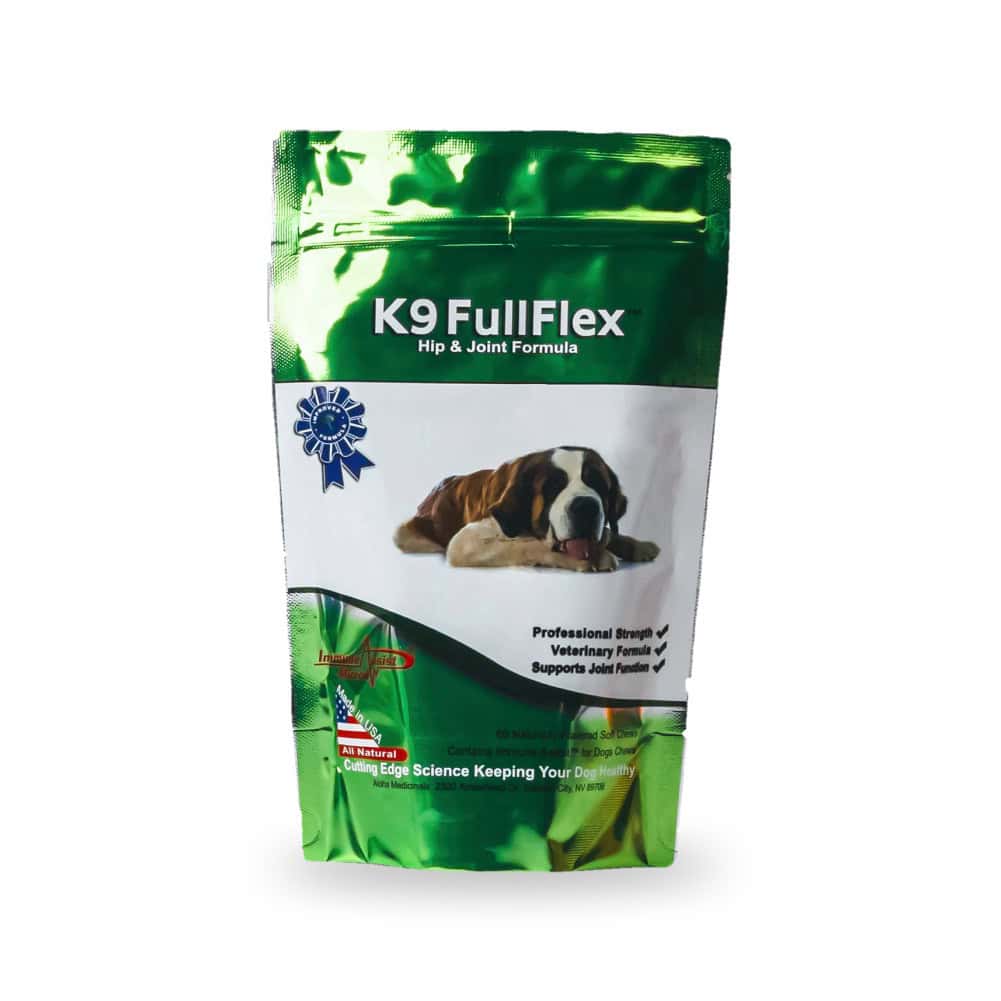If your dog is limping, struggling to get up, or walking oddly, one possible cause could be canine dysplasia. This condition is every dog owner’s nightmare, as it can cause long-term pain and mobility issues. However, if canine dysplasia is detected and treated in time, your dog can still live a long, happy, and pain-free life.
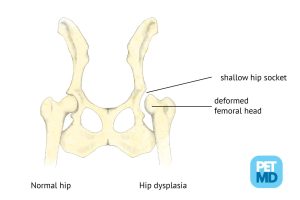
Source: petmd.com
In medical terminology, dysplasia means abnormal or pathological development. The bone ends forming the joints, and the cartilage surfaces covering them, do not fit together correctly. As a result of the poor alignment, degenerative joint changes (arthrosis), joint dislocation (subluxation), or cartilage wear may develop depending on the type and severity of dysplasia.
Appearance and spread of canine dysplasia
Dysplasia was unknown in natural living conditions (e.g., jackals, dingoes, wolves) or even a hundred years ago in working dogs such as shepherd’s pulis. Natural selection and breeding focused on performance prevented the spread of the condition.
In recent decades, however, the reasons and methods of dog breeding and ownership have changed.
“Pedigree” breeding, unprofessional puppy farming, lack of environmental stimulation compared to the breed’s needs, poor diet, and restricted living space (kennels, apartments, small yards) have all contributed to the rapid spread of canine dysplasia.
Development of canine dysplasia
Canine dysplasia is a hereditary developmental disorder, not an acquired disease. The recessive (latent) genes responsible for dysplasia are inherited before birth, but the condition is not immediately visible. Symptoms usually appear during early puppyhood (4–6 months).
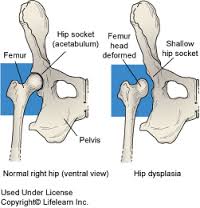 At the onset of dysplasia (often a few weeks old), joint fluid builds up, followed by loosening of the joint capsule and the whole joint within a few months. The looser the joint, the less accurate the alignment of the joint surfaces during movement.
At the onset of dysplasia (often a few weeks old), joint fluid builds up, followed by loosening of the joint capsule and the whole joint within a few months. The looser the joint, the less accurate the alignment of the joint surfaces during movement.
Poorly aligned joints are subjected to multiple forces under load, making them more prone to partial dislocations. These recurring subluxations initially cause joint inflammation, later cartilage wear, arthrosis, joint deformities, and muscle atrophy due to pain-related disuse.
The process, depending on the degree of joint looseness and predisposing factors (diet, exercise), gradually damages the joint and, over months or years, leads to bone changes detectable by X-ray.
Symptoms and locations of canine dysplasia
There are no symptoms unique only to canine dysplasia (only X-rays can confirm it), which is why it is important for suspicious signs to be evaluated by a veterinarian.
- Weakness of the hindquarters, limping, uneven gait
- Difficulty rising, reluctance to move, tiring quickly
- After resting, the dog starts stiffly, but improves as the joints “warm up”
- While walking, placing legs too close or too far apart, producing a “waddling” gait
- While trotting or running, the hind legs hit the ground together instead of alternately, resembling a rabbit hop
- Clicking sound from the joints during walking
Prevention and risk factors
Although dysplasia is genetic, the severity and course of the disease are also influenced by environmental factors. Prevention cannot always stop the disease, but it can greatly reduce symptom severity.
Careful breeding, proper nutrition, and a healthy lifestyle together help reduce the impact of canine dysplasia, allowing dogs to live pain-free for longer.
Dog breeds predisposed to dysplasia
Although theoretically any dog may be affected, some breeds show much higher rates of dysplasia due to genetics and body structure:
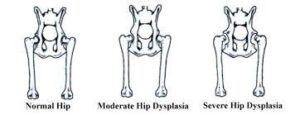 German shepherdLabrador retriever
German shepherdLabrador retriever- Golden retriever
- Bernese mountain dog
- Rottweiler
- Cane corso
- Bullmastiff
Nevertheless, small breeds can also be affected, so every owner should be alert to the signs.
Common misconceptions about dysplasia
There are many misconceptions about canine dysplasia among dog owners. It is important to see clearly, since myths often delay diagnosis and treatment.
- “Dysplasia only affects large dogs.” – Not true. While more common in large breeds, small dogs can also develop the condition.
- “Puppy play and running are always harmful.” – Not necessarily. Healthy exercise is beneficial; the problem lies in overexertion and poor environment.
- “If the parents are healthy, the puppy will be too.” – Unfortunately, there are no guarantees. Genetic risk can be reduced, but environmental factors also play a major role.
Dispelling these myths helps owners recognize problems earlier and act responsibly.
Types of canine dysplasia
- Hip dysplasia (HD) – (most often simply called dysplasia),
- Elbow dysplasia (ED) – (becoming increasingly significant).
- Shoulder dysplasia – (still less known)
Stages of canine dysplasia

- Breeding dysplastic dog (carries and passes on the disease, has abnormal joint structure proven by X-ray, but symptom-free and does not need treatment)
- Clinically dysplastic dog (carries and passes on the disease, has abnormal joint structure proven by X-ray, and shows mobility issues, limping, requiring treatment)
The stages of dysplasia mainly refer to breeding terminology. In Europe, including Hungary, the FCI (Fédération Cynologique Internationale) guidelines distinguish five stages.
Dysplasia screening
Screening usually occurs in two cases:
- When mobility issues prompt a veterinarian to recommend dysplasia screening.
- As preliminary or final screening required for breeding certification.
Preliminary screening is recommended around 6 months of age. Although hip development is not yet complete, severe cases can be identified early, which is important for breeding, diet, and exercise planning.
Final certification for pedigree registration depends on breed and club requirements, usually between 12–24 months. Having a final certificate is a basic condition of ethical breeding.
Don’t forget: elbow dysplasia (front legs) is almost as common as hip dysplasia. If you take your dog for hip screening, request elbow screening at the same time. Both can be done under a single anesthesia, reducing risks and costs compared to separate procedures.
Reducing the development and progression of dysplasia
One of the most important aspects of puppy development is proper bone and joint growth. This provides a stable frame for internal organs and a foundation for muscle mass. Growth during the first months is critical for later bone and muscle health.
The progression of dysplasia depends greatly on early diet, amount and quality of exercise, and environmental factors. Poor nutrition (too energy-dense but low in nutrients), excessive or insufficient activity, slippery floors, frequent stair climbing, or limited living space all worsen the condition.
Dysplasia passes down genetically, so owners cannot fully prevent it. However, when they provide the right lifestyle, arrange early screening, and give conscious care, they greatly reduce the symptoms. With these actions, dogs live longer, stay pain-free, and enjoy a good quality of life.
Diagnostic methods of canine dysplasia
Since symptoms of dysplasia are not always obvious, a veterinary examination is required for diagnosis. In addition to physical exams, imaging techniques provide the clearest view of joint condition.
Accurate diagnosis is important not only for treatment choices but also to exclude affected dogs from breeding, reducing the risk of transmission.
Natural support for canine dysplasia
Alongside medication and veterinary treatment, more and more natural compounds prove to be useful as complementary support. They cannot cure dysplasia, but they may help relieve symptoms, reduce inflammation, and improve joint function.
- Omega-3 fatty acids (EPA, DHA): their anti-inflammatory effects may improve mobility. (K9 INUKrill®)
- Green-lipped mussel extract: a natural source of glucosamine and chondroitin, supporting cartilage elasticity.
- Eggshell membrane (ESM): with its complex mix of collagen, glucosamine, chondroitin, and hyaluronic acid, it may support joint flexibility and help reduce inflammation.
- Collagen peptides: may contribute to cartilage and connective tissue regeneration.
- Curcumin: a strong antioxidant and natural anti-inflammatory.
- Boswellia serrata: may ease joint pain and reduce inflammation.
- Hyaluronic acid: improves the lubricating capacity of joint fluid.
- Vitamins (C and E): act as antioxidants, protecting cartilage from damage.
These natural supplements cannot replace medical treatment, but they may help slow the progression of dysplasia and improve your dog’s quality of life.
Treatment
Regardless of the dysplasia stage your dog is diagnosed with, you can improve their condition if you:
- Maintain ideal weight through a tailored diet for dysplasia and proper exercise program. Avoid overexertion in puppies; don’t force activity when they’re tired. At the same time, avoid inactivity, since hip and gluteal muscle development requires regular exercise.
- Provide supplements rich in natural anti-inflammatory and cartilage-protecting substances, such as K9 INUFlex® or K9 FullFlex™.
Lifestyle and home care for dogs with dysplasia
Canine dysplasia is not only a medical issue: everyday care can greatly improve your dog’s condition. Proper lifestyle and environment help reduce pain and maintain quality of life.
Daily care is essential. An attentive owner and consistent lifestyle adjustments can allow a dysplastic dog to live an active, happy, and balanced life.
Mild dysplasia for breeding purposes is not necessarily negative. In some breeds, such a dog may still be recommended for breeding and live a symptom-free life.
In many moderate cases, detected early, progression can be slowed with medication or nutritional supplements, along with a tailored diet and exercise program.
Even severe cases have treatment options, from modern surgical procedures to alternative therapies (such as gold bead implantation), which can greatly improve condition.
Prognosis and quality of life
The severity of canine dysplasia, the dog’s age, and the timing of treatment and lifestyle adjustments determine the prognosis. Owners can often manage mild cases successfully, and dogs live long, active, and pain-free lives. Consistent care and veterinary therapy slow the progression of moderate dysplasia. In severe cases, veterinarians perform surgery or apply special treatments, and these steps improve the dog’s quality of life.
Frequently asked questions about canine dysplasia (FAQ)
❓ At what age do symptoms of canine dysplasia appear?
The first symptoms of canine dysplasia often appear between 4–6 months of age, but may only become visible in young adult dogs. A veterinary exam is always required for diagnosis.
❓ Can canine dysplasia be prevented?
Since dysplasia is hereditary, complete prevention is impossible. However, responsible breeding, balanced diet, weight control, and regular gentle exercise can significantly reduce severity of symptoms.
❓ What treatments are available for canine dysplasia?
Treatment depends on severity. Mild cases may only need proper diet, gentle exercise, and supplements, while more severe dysplasia may require medication or surgery.
❓ Can my dog live a full life with dysplasia?
Yes, dogs with dysplasia can still live long and happy lives with proper care, diet, and regular veterinary checks. Early detection and lifestyle management are crucial for maintaining quality of life.
Summary
In conclusion, canine dysplasia does not necessarily mean a drastic loss of quality of life. An attentive owner, proper veterinary care, and consistent home management are key to ensuring a long, active, and pain-free life.
With the right diet, exercise, and supplements, the risk and severity of canine dysplasia symptoms can be significantly reduced! Prevention remains one of the most important steps.
Related articles on joint health and natural support for dogs
For more useful reading, explore our related articles: learn about cartilage degeneration in dogs, how dysplasia can be supported with proper nutrition, and why the dog–human relationship is so unique. You can also read why cartilage support in dogs matters and discover the benefits of green-lipped mussel extract for canine health.
Important: This article is for informational purposes and does not replace veterinary diagnosis or treatment. Always consult your veterinarian for accurate diagnosis and proper therapy.
References
- Schachner, E. R., & Lopez, M. J. (2015). Diagnosis, prevention, and management of canine hip dysplasia: a review. Veterinary Medicine: Research and Reports, 6, 181–192.
- Manfredi, S., Di Ianni, F., Gnudi, G., Miduri, F., Fabbi, M., Daga, A., & others. (2018). Effect of a commercially available fish-based dog food enriched with nutraceuticals on hip and elbow dysplasia in growing Labrador retrievers. Canadian Journal of Veterinary Research, 82(2), 154–158.
- Willemsen, K., et al. (2021). Comparing hip dysplasia in dogs and humans: A review. Frontiers in Veterinary Science, 8, 791434.
- Fries, C. L. (1995). The pathogenesis and diagnosis of canine hip dysplasia. Veterinary Clinics of North America: Small Animal Practice, 25(4), 791–812.
- Vidoni, B., et al. (2021). Early diagnosis of canine hip laxity: Correlation between clinical orthopedic examinations and the Fédération Cynologique Internationale (FCI) scoring method. Animals, 11(2), 416.
- Mikkola, L., et al. (2019). Genetic dissection of canine hip dysplasia phenotypes and loci associated with joint incongruity. BMC Genomics, 20, 6422.
- Cornell University, Riney Canine Health Center. (n.d.). How joint supplements can help with orthopedic conditions. Cornell University College of Veterinary Medicine.
